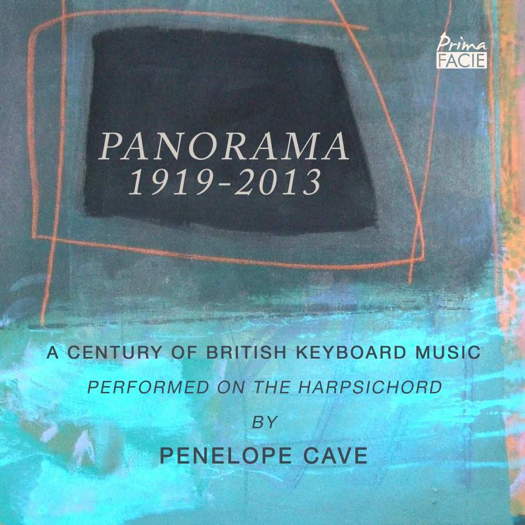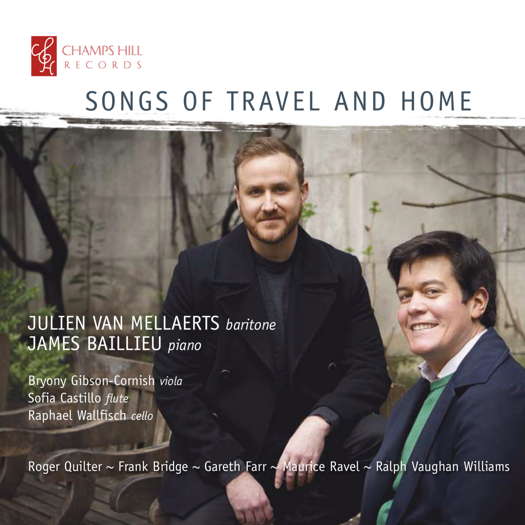 SPONSORED: CD Spotlight. A Fantastic Collection. Penelope Cave Panorama CD. Little-known harpsichord gems, strongly recommended by Alice McVeigh.
SPONSORED: CD Spotlight. A Fantastic Collection. Penelope Cave Panorama CD. Little-known harpsichord gems, strongly recommended by Alice McVeigh.
All sponsored features >>
- AVI Musica Autentica
- Pascal Bentoiu
- Antoine Busnois
- Valery Khalilov
- Beethoven: Piano Sonata No 26
- Petr Eben
- Langgaard: Interdict
- Debussy: Sonata for Flute
 VIDEO PODCAST: Come and meet Eric Fraad of Heresy Records, Kenneth Woods, musical director of Colorado MahlerFest and the English Symphony Orchestra and others.
VIDEO PODCAST: Come and meet Eric Fraad of Heresy Records, Kenneth Woods, musical director of Colorado MahlerFest and the English Symphony Orchestra and others.

Birdsong Fragments
'Songs of Travel and Home' performed by Jullien van Mellaerts, recommended by GEOFF PEARCE
'... a singer with a very expressive voice, a pleasing tone, a great insight into the music he sings ...'
I am very pleased to review this disc as three of my compatriots are featured on this disc, one as a composer and two as performers, and the disc also includes an all time favourite in Vaughan Willams' Songs of Travel. This disc appealed to me instantly, first because of the quality of the performances, but it is a very nice programme and the accompanying booklet is excellent.
The first work on the disc, Go, Lovely Rose by Roger Quilter, written sometime between 1922-28, is a beautiful song that is tender but bitter sweet, as it is a reflection on an unrequited love.
Listen — Roger Quilter: Go, Lovely Rose
(track 1, 1:11-1:47) ℗ 2021 Champs Hill Records :
Whilst Three Songs for medium voice, viola and piano were composed in 1906-1907, it was not too much later that they were published. Frank Bridge was a fine pianist and viola player, so he writes confidently for this combination. All the songs are rather poignant and again deal with the often sad aspects of love.
Listen — Frank Bridge: Where is it that our soul doth go?
(Three Songs for medium voice, viola and piano)
(track 3, 0:39-1:18) ℗ 2021 Champs Hill Records :
The next song is again by Roger Quilter, Now Sleeps the Crimson Petal. Written in 1904-05, it depicts a princess reading a poem while an injured prince is sleeping.
Ornithological Anecdotes was the result of a collaboration between the singer, the pianist and New Zealand poet Bill Manhire and New Zealand composer Gareth Farr (whose music I have admired for some time). Many New Zealand birds are endangered or rare, and this work comprises five songs, each with a bird in mind. This music depicts birdsong fragments, and paints a picture of the character of each of the birds.
The first bird, 'Dotterel', is a wading bird that often leads an encroaching predator away from its eggs, laid in rocks in the sand of river beds and beach areas. It is delicate and plaintive as one imagines the bird in this behaviour.
Listen — Gareth Farr: Dotterel (Ornithological Anecdotes)
(track 6, 0:00-0:48) ℗ 2021 Champs Hill Records :
The Takehe is a large flightless swamp loving bird, very endangered and at one stage thought to be extinct until an amateur ornithologist found the remaining pocket in a remote area in the South Island. This song grows in strength as the song progresses, as the bird's numbers are increasing on predator-free off shore islands.
The Huia is an extinct wattle bird. At one stage they were plentiful, but around the turn of the twentieth century, they became extinct. They were prized for their feathers which were used in ceremonial cloaks, but habitat loss, introduced predators and trapping led to their demise. They were the birds that were amongst the first to sing in the morning. This song is a sad echo of their passing.
Listen — Gareth Farr: Huia (Ornithological Anecdotes)
(track 8, 1:00-1:43) ℗ 2021 Champs Hill Records :
The Kiwi is next, and basically he introduces himself and says how humble he is, but is not afraid of highlighting his accomplishments.
Lastly there is the Tūī. This is one bird that is making somewhat of a comeback as more gardens are planting native trees, like the Kowhai, and there is an ongoing project to rid the county of introduced predators. These birds are noisy and playful, and often get drunk on the nectar of some of the flowering trees. The composer here has very skilfully captured the unique Tūī calls. This my favourite song in this cycle.
Listen — Gareth Farr: Tūī (Ornithological Anecdotes)
(track 10, 1:05-1:46) ℗ 2021 Champs Hill Records :
Maurice Ravel is next with three Chansons Madécasses for voice, cello, flute and piano. These were written in 1925 and depict scenes from the life of villagers in Madagascar. The voice is treated as one of the instruments around which the others entwine. Ravel considered these three works as one of the most important of his compositions and acknowledges a debt to Schoenberg in the way the three instruments surround the voice.
Listen — Maurice Ravel: Il est doux (Chansons Madécasses)
(track 13, 0:19-1:18) ℗ 2021 Champs Hill Records :
The three songs comprising Don Quichotte à Dulcinée were composed in 1932-1933 and are his last vocal songs. They were originally written for a film featuring Chaliapin but were not completed in time and the composer was never paid for them. The songs are contrasting, reflect Ravel's strong Basque heritage and have a distinctive Spanish flavour. They are popular in recital.
The final set are by Vaughan Williams who was a very fine song writer, a fact often overlooked outside the UK, and this set, Songs of Travel, is perhaps his most popular. I heard it many times in my youth as my home town had many fine singers who loved presenting it. To this day it remains one of my favourite works. It was written in 1904-05 and sets some of the poems of Robert Louis Stevenson. These nine songs are in a loosely knit cycle that tells the story of a love affair. There are many great recordings of this cycle, and this recording stands up with the best of them. Julien Van Mellaert's voice is really suited to this work. James Baillieu is a superlative associate artist. Every track is a gem.
Listen — Vaughan Williams: The roadside fire (Songs of Travel)
(track 19, 1:08-1:53) ℗ 2021 Champs Hill Records :
This is a fantastic disc: a singer with a very expressive voice, a pleasing tone, a great insight into the music he sings, and accuracy of pitch, and a very fine accompanist, and other associated artists. In my mind, this is a must have recording.
Copyright © 16 September 2021
Geoff Pearce,
Sydney, Australia

CD INFORMATION: SONGS OF TRAVEL AND HOME


